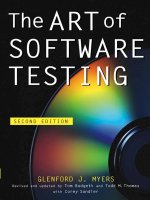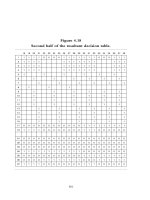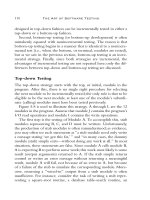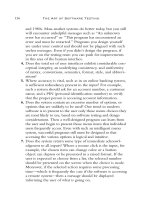The art of software testing second edition - phần 5 potx
Bạn đang xem bản rút gọn của tài liệu. Xem và tải ngay bản đầy đủ của tài liệu tại đây (892.32 KB, 15 trang )
Chapter 4: Test-Case Design
Figure 4.16: Sample graph to illustrate the tracing considerations.
Assume that we want to locate all input conditions that cause the output state to be 0.
Consideration 3 states that we should list only one circumstance where nodes 5 and 6 are 0.
Consideration 2 states that, for the state where node 5 is 1 and node 6 is 0, we should list only
one circumstance where node 5 is 1, rather than enumerating all possible ways that node 5 can
be 1. Likewise, for the state where node 5 is 0 and node 6 is 1, we should list only one
circumstance where node 6 is 1 (although there is only one in this example). Consideration 1
states that where node 5 should be set to 1, we should not set nodes 1 and 2 to 1 simultaneously.
Hence, we would arrive at five states of nodes 1 through 4, for example, the values81 rather
than the 13 possible states of nodes 1 through 4 that lead to a 0 output state.
0 0 0 0 (5=0, 6= 0)
1 0 0 0 (5=1, 6= 0)
1 0 0 1 (5=1, 6= 0)
1 0 1 0 (5=1, 6= 0)
0 0 1 1 (5=0, 6= 1)
These considerations may appear to be capricious, but they have an important purpose: to lessen
the combined effects of the graph. They eliminate situations that tend to be low-yield test cases.
If low- yield test cases are not eliminated, a large cause-effect graph will produce an
astronomical number of test cases. If the number of test cases is too large to be practical, you
will select some subset, but there is no guarantee that the low-yield test cases will be the ones
eliminated. Hence, it is better to eliminate them during the analysis of the graph.
The cause-effect graph in
Figure 4.14 will now be converted into the decision table. Effect 91
will be selected first. Effect 91 is present if node 36 is 0. Node 36 is 0 if nodes 32 and 35 are
0,0; 0,1; or 1,0; and considerations 2 and 3 apply here. By tracing back to the causes and
considering the constraints among causes, you can find the combinations of causes that lead to
effect 91 being present, although doing so is a laborious process.
The Art of Software Testing - Second Edition Página 61
Simpo PDF Merge and Split Unregistered Version -
Chapter 4: Test-Case Design
The resultant decision table under the condition that effect 91 is present is shown in Figure 4.17
(columns 1 through 11). Columns (tests) 1 through 3 represent the conditions where node 32 is
0 and node 35 is 1. Columns 4 through 10 represent the conditions where node 32 is 1 and node
35 is 0. Using consideration 3, only one situation (column 11) out of a possible 21 situations
where nodes 32 and 35 are 0 is identified. Blanks in the table represent “don’t care” situations
(i.e., the state of the cause is irrelevant) or indicate that the state of a cause is obvious because of
the states of other dependent causes (e.g., in column 1, we know that causes 5, 7, and 8 must be
0 because they exist in an “at most one” situation with cause 6).
The Art of Software Testing - Second Edition Página 62
Simpo PDF Merge and Split Unregistered Version -
Chapter 4: Test-Case Design
Figure 4.17: First half of the resultant decision table.
Columns 12 through 15 represent the situations where effect 92 is present. Columns 16 and 17
represent the situations where effect 93 is present.
Figure 4.18 represents the remainder of the
decision table.
The Art of Software Testing - Second Edition Página 63
Simpo PDF Merge and Split Unregistered Version -
Chapter 4: Test-Case Design
Figure 4.18: Second half of the resultant decision table.
The last step is to convert the decision table into 38 test cases. A set of 38 test cases is listed
here. The number or numbers beside each test case designate the effects that are expected to be
present. Assume that the last location in memory on the machine being used is 7FFF.
1 DISPLAY 234AF74-123 (91)
2 DISPLAY 2ZX4-3000 (91)
3 DISPLAY HHHHHHHH-2000 (91)
4 DISPLAY 200 200 (91)
5 DISPLAY 0-22222222 (91)
6 DISPLAY 1-2X (91)
The Art of Software Testing - Second Edition Página 64
Simpo PDF Merge and Split Unregistered Version -
Chapter 4: Test-Case Design
7 DISPLAY 2-ABCDEFGHI (91)
8 DISPLAY 3.1111111 (91)
9 DISPLAY 44.$42 (91)
10 DISPLAY 100.$$$$$$$ (91)
11 DISPLAY 10000000-M (91)
12 DISPLAY FF-8000 (92)
13 DISPLAY FFF.7001 (92)
14 DISPLAY 8000-END (92)
15 DISPLAY 8000-8001 (92)
16 DISPLAY AA-A9 (93)
17 DISPLAY 7000.0 (93)
18 DISPLAY 7FF9-END (94, 97)
19 DISPLAY 1 (94, 97)
20 DISPLAY 21-29 (94, 97)
21 DISPLAY 4021.A (94, 97)
22 DISPLAY -END (94, 96)
23 DISPLAY (94, 96)
24 DISPLAY -F (94, 96)
25 DISPLAY .E (94, 96)
26 DISPLAY 7FF8-END (94, 96)
27 DISPLAY 6000 (94, 96)
28 DISPLAY A0-A4 (94, 96)
29 DISPLAY 20.8 (94, 96)
30 DISPLAY 7001-END (95, 97)
31 DISPLAY 5-15 (95, 97)
32w DISPLAY 4FF.100 (95, 97)
33 DISPLAY -END (95, 96)
34 DISPLAY -20 (95, 96)
35 DISPLAY .11 (95, 96)
36 DISPLAY 7000-END (95, 96)
37 DISPLAY 4-14 (95, 96)
38 DISPLAY 500.11 (95, 96)
Note that where two or more different test cases invoked, for the most part, the same set of
causes, different values for the causes were selected to slightly improve the yield of the test
cases. Also note that, because of the actual storage size, test case 22 is impossible (it will yield
effect 95 instead of 94, as noted in test case 33). Hence, 37 test cases have been identified.
The Art of Software Testing - Second Edition Página 65
Simpo PDF Merge and Split Unregistered Version -
Chapter 4: Test-Case Design
Remarks
Cause-effect graphing is a systematic method of generating test cases representing combinations
of conditions. The alternative would be an ad hoc selection of combinations, but, in doing so, it
is likely that you would overlook many of the “interesting” test cases identified by the cause-
effect graph.
Since cause-effect graphing requires the translation of a specification into a Boolean logic
network, it gives you a different perspective on, and additional insight into, the specification. In
fact, the development of a cause-effect graph is a good way to uncover ambiguities and
incompleteness in specifications. For instance, the astute reader may have noticed that this
process has uncovered a problem in the specification of the
DISPLAY command. The
specification states that all output lines contain four words. This cannot be true in all cases; it
cannot occur for test cases 18 and 26 since the starting address is less than 16 bytes away from
the end of memory.
Although cause-effect graphing does produce a set of useful test cases, it normally does not
produce all of the useful test cases that might be identified. For instance, in the example we said
nothing about verifying that the displayed memory values are identical to the values in memory
and determining whether the program can display every possible value in a memory location.
Also, the cause-effect graph does not adequately explore boundary conditions. Of course, you
could attempt to cover boundary conditions during the process. For instance, instead of
identifying the single cause
hexloc2 hexloc1
you could identify two causes:
hexloc2
=
hexloc1
hexloc2
>
hexloc1
The problem in doing this, however, is that it complicates the graph tremendously and leads to
an excessively large number of test cases. For this reason it is best to consider a separate
boundary-value analysis. For instance, the following boundary conditions can be identified for
the
DISPLAY specification:
1. hexloc1 has one digit.
2. hexloc1 has six digits.
3. hexloc1 has seven digits.
4. hexloc1 = 0.
5. hexloc1 = 7FFF.
6. hexloc1 = 800
7. hexloc2 has one digit.
8. hexloc2 has six digits.
9. hexloc2 has seven digits.
10. hexloc2 =
11. hexloc2 = 7FFF.
12. hexloc2 = 800
The Art of Software Testing - Second Edition Página 66
Simpo PDF Merge and Split Unregistered Version -
Chapter 4: Test-Case Design
13. hexloc2 = hexloc
14. hexloc2 = hexloc1 +
15. hexloc2 = hexloc1 −
16. bytecount has one digit.
17. bytecount has six digits.
18. bytecount has seven digits.
19. bytecount =
20. hexloc1 + bytecount = 800
21. hexloc1 + bytecount = 800
22. display 16 bytes (one line).
23. display 17 bytes (two lines).
Note that this does not imply that you would write 60 (37 + 23) test cases. Since the cause-effect
graph gives us leeway in selecting specific values for operands, the boundary conditions could
be blended into the test cases derived from the cause-effect graph. In this example, by rewriting
some of the original 37 test cases, all 23 boundary conditions could be covered without any
additional test cases. Thus, we arrive at a small but potent set of test cases that satisfy both
objectives.
Note that cause-effect graphing is consistent with several of the testing principles in Chapter 2.
Identifying the expected output of each test case is an inherent part of the technique (each
column in the decision table indicates the expected effects). Also note that it encourages us to
look for unwanted side effects. For instance, column (test) 1 specifies that you should expect
effect 91 to be present and that effects 92 through 97 should be absent.
The most difficult aspect of the technique is the conversion of the graph into the decision table.
This process is algorithmic, implying that you could automate it by writing a program; several
commercial programs exist to help with the conversion.
Error Guessing
It has often been noted that some people seem to be naturally adept at program testing. Without
using any particular methodology such as boundary-value analysis of cause-effect graphing,
these people seem to have a knack for sniffing out errors.
One explanation of this is that these people are practicing, subconsciously more often than not, a
test-case-design technique that could be termed error guessing. Given a particular program, they
surmise, both by intuition and experience, certain probable types of errors and then write test
cases to expose those errors.
It is difficult to give a procedure for the error-guessing technique since it is largely an intuitive
and ad hoc process. The basic idea is to enumerate a list of possible errors or error-prone
situations and then write test cases based on the list. For instance, the presence of the value 0 in
a program’s input is an error-prone situation. Therefore, you might write test cases for which
particular input values have a 0 value and for which particular output values are forced to 0.
Also, where a variable number of inputs or outputs can be present (e.g., the number of entries in
a list to be searched), the cases of “none” and “one” (e.g., empty list, list containing just one
entry) are error-prone situations. Another idea is to identify test cases associated with
assumptions that the programmer might have made when reading the specification (i.e., things
The Art of Software Testing - Second Edition Página 67
Simpo PDF Merge and Split Unregistered Version -
Chapter 4: Test-Case Design
that were omitted from the specification, either by accident or because the writer felt them to be
obvious).
Since a procedure cannot be given, the next-best alternative is to discuss the spirit of error
guessing, and the best way to do this is by presenting examples. If you are testing a sorting
subroutine, the following are situations to explore:
• The input list is empty.
• The input list contains one entry.
• All entries in the input list have the same value.
• The input list is already sorted.
In other words, you enumerate those special cases that may have been overlooked when the
program was designed. If you are testing a binary-search subroutine, you might try the situations
where (1) there is only one entry in the table being searched, (2) the table size is a power of two
(e.g., 16), and (3) the table size is one less than and one greater than a power of two (e.g., 15 or
17).
Consider the MTEST program in the section on boundary-value analysis. The following
additional tests come to mind when using the error-guessing technique:
• Does the program accept “blank” as an answer?
• A type-2 (answer) record appears in the set of type-3 (student) records.
• A record without a 2 or 3 in the last column appears as other than the initial (title)
record.
• Two students have the same name or number.
• Since a median is computed differently depending on whether there is an odd or an even
number of items, test the program for an even number of students and an odd number of
students.
• The number-of-questions field has a negative value.
Error-guessing tests that come to mind for the
DISPLAY command of the previous section are
as follows:
• DISPLAY 100- (partial second operand)
• DISPLAY 100. (partial second operand)
• DISPLAY 100-10A 42 (extra operand)
• DISPLAY 000-0000FF (leading zeros)
The Strategy
The test-case-design methodologies discussed in this chapter can be combined into an overall
strategy. The reason for combining them should be obvious by now: Each contributes a
particular set of useful test cases, but none of them by itself contributes a thorough set of test
cases. A reasonable strategy is as follows:
1. If the specification contains combinations of input conditions, start with cause-effect
graphing.
2. In any event, use boundary-value analysis. Remember that this is an analysis of input
and output boundaries. The boundary-value analysis yields a set of supplemental test
The Art of Software Testing - Second Edition Página 68
Simpo PDF Merge and Split Unregistered Version -
Chapter 4: Test-Case Design
conditions, but, as noted in the section on cause-effect graphing, many or all of these can
be incorporated into the cause-effect tests.
3. Identify the valid and invalid equivalence classes for the input and output, and
supplement the test cases identified above if necessary.
4. Use the error-guessing technique to add additional test cases.
5. Examine the program’s logic with regard to the set of test cases. Use the decision-
coverage, condition-coverage, decision/condition-coverage, or multiple-condition-
coverage criterion (the last being the most complete). If the coverage criterion has not
been met by the test cases identified in the prior four steps, and if meeting the criterion is
not impossible (i.e., certain combinations of conditions may be impossible to create
because of the nature of the program), add sufficient test cases to cause the criterion to
be satisfied.
Again, the use of this strategy will not guarantee that all errors will be found, but it has been
found to represent a reasonable compromise. Also, it represents a considerable amount of hard
work, but no one has ever claimed that program testing is easy.
The Art of Software Testing - Second Edition Página 69
Simpo PDF Merge and Split Unregistered Version -
Chapter 5: Module (Unit) Testing
Chapter 5: Module (Unit) Testing
Overview
Up to this point we have largely ignored the mechanics of testing and the size of the program
being tested. However, large programs (say, programs of 500 statements or more) require
special testing treatment. In this chapter we consider an initial step in structuring the testing of a
large program: module testing.
Chapter 6 discusses the remaining steps.
Module testing (or unit testing) is a process of testing the individual subprograms, subroutines,
or procedures in a program. That is, rather than initially testing the program as a whole, testing
is first focused on the smaller building blocks of the program. The motivations for doing this are
threefold. First, module testing is a way of managing the combined elements of testing, since
attention is focused initially on smaller units of the program. Second, module testing eases the
task of debugging (the process of pinpointing and correcting a discovered error), since, when an
error is found, it is known to exist in a particular module. Finally, module testing introduces
parallelism into the program testing process by presenting us with the opportunity to test
multiple modules simultaneously.
The purpose of module testing is to compare the function of a module to some functional or
interface specification defining the module. To reemphasize the goal of all testing processes, the
goal here is not to show that the module meets its specification, but to show that the module
contradicts the specification. In this chapter we discuss module testing from three points of
view:
1. The manner in which test cases are designed.
2. The order in which modules should be tested and integrated.
3. Advice about performing the test.
Test-Case Design
You need two types of information when designing test cases for a module test: a specification
for the module and the module’s source code. The specification typically defines the module’s
input and output parameters and its function.
Module testing is largely white-box oriented. One reason is that as you test larger entities such
as entire programs (which will be the case for subsequent testing processes), white-box testing
becomes less feasible. A second reason is that the subsequent testing processes are oriented
toward finding different types of errors (for example, errors not necessarily associated with the
program’s logic, such as the program’s failing to meet its users’ requirements). Hence, the test-
case-design procedure for a module test is the following: Analyze the module’s logic using one
or more of the white-box methods, and then supplement these test cases by applying black-box
methods to the module’s specification.
Since the test-case-design methods to be used have already been defined in
Chapter 4, their use
in a module test is illustrated here through an example. Assume that we wish to test a module
named BONUS, and its function is to add $2,000 to the salary of all employees in the
department or departments having the largest sales amount. However, if an eligible employee’s
The Art of Software Testing - Second Edition Página 70
Simpo PDF Merge and Split Unregistered Version -
Chapter 5: Module (Unit) Testing
current salary is $150,000 or more, or if the employee is a manager, the salary is increased by
only $1,000.
The inputs to the module are the tables shown in
Figure 5.1. If the module performs its function
correctly, it returns an error code of 0. If either the employee or the department table contains no
entries, it returns an error code of 1. If it finds no employees in an eligible department, it returns
an error code of 2.
Figure 5.1: Input tables to module BONUS.
The module’s source code is shown in Figure 5.2. Input parameters ESIZE and DSIZE contain
the number of entries in the employee and department tables. The module is written in PL/1, but
the following discussion is largely language independent; the techniques are applicable to
programs coded in other languages. Also, since the PL/1 logic in the module is fairly simple,
virtually any reader, even those not familiar with PL/1, should be able to understand it.
The Art of Software Testing - Second Edition Página 71
Simpo PDF Merge and Split Unregistered Version -
Chapter 5: Module (Unit) Testing
Figure 5.2: Module BONUS.
Regardless of which of the logic-coverage techniques you use, the first step is to list the
conditional decisions in the program. Candidates in this program are all
IF and DO statements.
The Art of Software Testing - Second Edition Página 72
Simpo PDF Merge and Split Unregistered Version -
Chapter 5: Module (Unit) Testing
By inspecting the program, we can see that all of the DO statements are simple iterations, each
iteration limit will be equal to or greater than the initial value (meaning that each loop body
always will execute at least once), and the only way of exiting each loop is via the
DO
statement. Thus, the
DO statements in this program need no special attention, since any test case
that causes a
DO statement to execute will eventually cause it to branch in both directions (i.e.,
enter the loop body and skip the loop body). Therefore, the statements that must be analyzed are
2 IF (ESIZE<=O) | (DSIZE<=0)
6 IF (SALES(I) >= MAXSALES)
9 IF (SALES(J) = MAXSALES)
13 IF (EMPTAB.DEPT(K) = DEPTTAB.DEPT(J))
16 IF (SALARY(K) >= LSALARY) | (CODE(K) =MGR)
21 IF(-FOUND) THEN ERRCODE=2
Given the small number of decisions, we probably should opt for multicondition coverage, but
we shall examine all the logic-coverage criteria (except statement coverage, which always is too
limited to be of use) to see their effects.
To satisfy the decision-coverage criterion, we need sufficient test cases to evoke both outcomes
of each of the six decisions. The required input situations to evoke all decision outcomes are
listed in
Table 5.1. Since two of the outcomes will always occur, there are 10 situations that
need to be forced by test cases. Note that to construct
Table 5.1: Situations Corresponding to the Decision Outcomes
Decision True Outcome False Outcome
2 ESIZE or DSIZE ≤ 0. ESIZE and DSIZE > 0.
6 Will always occur at least once. Order DEPTTAB so that a department with
lower sales occurs after a department with
higher sales.
9 Will always occur at least once. All departments do not have the same sales.
13 There is an employee in an
eligible department.
There is an employee who is not in an eligible
department.
16 An eligible employee is either a
manager or earns
LSALARY or
more.
An eligible employee is not a manager and
earns less than
LSALARY.
21 All eligible departments contain
no employees.
An eligible department contains at least one
employee.
Table 5.1, decision-outcome circumstances had to be traced back through the logic of the
program to determine the proper corresponding input circumstances. For instance, decision 16 is
not evoked by any employee meeting the conditions; the employee must be in an eligible
department.
The 10 situations of interest in
Table 5.1 could be evoked by the two test cases shown in Figure
5.3. Note that each test case includes a definition of the expected output, in adherence to the
principles discussed in
Chapter 2.
The Art of Software Testing - Second Edition Página 73
Simpo PDF Merge and Split Unregistered Version -
Chapter 5: Module (Unit) Testing
Figure 5.3: Test cases to satisfy the decision-coverage criterion.
Although these two test cases meet the decision-coverage criterion, it should be obvious that
there could be many types of errors in the module that are not detected by these two test cases.
For instance, the test cases do not explore the circumstances where the error code is 0, an
employee is a manager, or the department table is empty
(DSIZE<=0).
A more satisfactory test can be obtained by using the condition- coverage criterion. Here we
need sufficient test cases to evoke both outcomes of each condition in the decisions. The
conditions and required input situations to evoke all outcomes are listed in
Table 5.2. Since two
of the outcomes will always occur, there are 14 situations that must be forced by test cases.
Again, these situations can be evoked by only two test cases, as shown in
Figure 5.4.
Table 5.2: Situations Corresponding to the Condition Outcomes
Decision Condition True Outcome False Outcome
2 ESIZE ≤ 0 ESIZE ≤ 0 ESIZE > 0
2 DSIZE ≤ 0 DSIZE ≤ 0 DSIZE > 0
6
SALES (I) ≤
MAXSALES
Will always occur at
least once.
Order
DEPTTAB so that a
department with lower sales
occurs after a department
with higher sales.
9 SALES (J) = MAXSALES Will always occur at
least once.
All departments do not have
the same sales.
13 EMPTAB.DEPT(K) =
DEPTTAB.DEPT(J)
There is an employee in
an eligible department.
There is an employee who is
not in an eligible
department.
16
SALARY (K) ≥
LSALARY
An eligible employee
earns LSALARY or
more.
An eligible employee earns
less than
LSALARY.
16 CODE (K) ≤ MGR An eligible employee is
a manager.
An eligible employee is not
a manager.
The Art of Software Testing - Second Edition Página 74
Simpo PDF Merge and Split Unregistered Version -
Chapter 5: Module (Unit) Testing
Table 5.2: Situations Corresponding to the Condition Outcomes
Decision Condition True Outcome False Outcome
21 -FOUND An eligible department
contains no employees.
An eligible department
contains at least one
employee.
The test cases in Figure 5.4 were designed to illustrate a problem. Since they do evoke all the
outcomes in Table 5.2, they satisfy the condition-coverage criterion, but they are probably a
poorer set of test cases than those in
Figure 5.3 in terms of satisfying the decision- coverage
criterion. The reason is that they do not execute every statement. For example, statement 18 is
never executed. Moreover, they do not accomplish much more than the test cases in Figure 5.3.
They do not cause the output situation
ERRORCODE=0. If statement 2 had erroneously said
(ESIZE=0) and (DSIZE=0), this error would go undetected. Of course, an alternative set of test
cases might solve these problems, but the fact remains that the two test cases in Figure5.4 do
satisfy the condition-coverage criterion.
Figure 5.4: Test cases to satisfy the condition-coverage criterion.
Using the decision/condition-coverage criterion would eliminate the big weakness in the test
cases in
Figure 5.4. Here we would provide sufficient test cases such that all outcomes of all
conditions and decisions were evoked at least once. Making Jones a manager and making Lorin
a nonmanager could accomplish this. This would have the result of generating both outcomes of
decision 16, thus causing us to execute statement 18.
One problem with this, however, is that it is essentially no better than the test cases in
Figure
5.3. If the compiler being used stops evaluating an or expression as soon as it determines that
one operand is true, this modification would result in the expression
CODE(K)=MGR in
statement 16 never having a true outcome. Hence, if this expression were coded incorrectly, the
test cases would not detect the error.
The last criterion to explore is multicondition coverage. This criterion requires sufficient test
cases that all possible combinations of conditions in each decision are evoked at least once. This
can be accomplished by working from
Table 5.2. Decisions 6, 9, 13, and 21 have two
The Art of Software Testing - Second Edition Página 75
Simpo PDF Merge and Split Unregistered Version -









